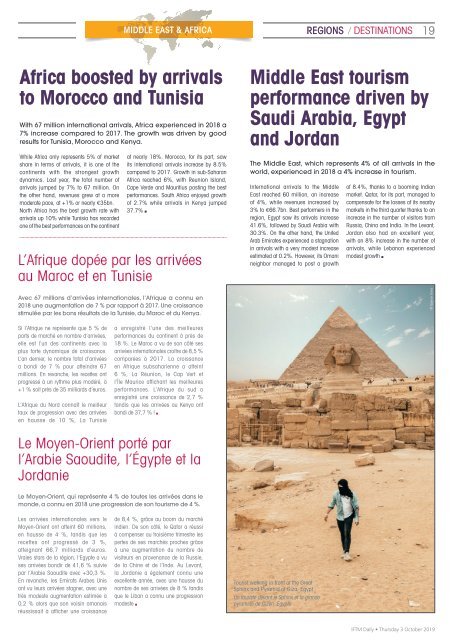Create successful ePaper yourself
Turn your PDF publications into a flip-book with our unique Google optimized e-Paper software.
MIDDLE EAST & AFRICA<br />
REGIONS / DESTINATIONS 19<br />
Africa boosted by arrivals<br />
to Morocco and Tunisia<br />
With 67 million international arrivals, Africa experienced in 2018 a<br />
7% increase compared to 2017. The growth was driven by good<br />
results for Tunisia, Morocco and Kenya.<br />
While Africa only represents 5% of market<br />
share in terms of arrivals, it is one of the<br />
continents with the strongest growth<br />
dynamics. Last year, the total number of<br />
arrivals jumped by 7% to 67 million. On<br />
the other hand, revenues grew at a more<br />
moderate pace, at +1% or nearly €35bn.<br />
North Africa has the best growth rate with<br />
arrivals up 10% while Tunisia has recorded<br />
one of the best performances on the continent<br />
at nearly 18%. Morocco, for its part, saw<br />
its international arrivals increase by 8.5%<br />
compared to 2017. Growth in sub-Saharan<br />
Africa reached 6%, with Reunion Island,<br />
Cape Verde and Mauritius posting the best<br />
performances. South Africa enjoyed growth<br />
of 2.7% while arrivals in Kenya jumped<br />
37.7%<br />
L’Afrique dopée par les arrivées<br />
au Maroc et en Tunisie<br />
Avec 67 millions d’arrivées internationales, l’Afrique a connu en<br />
2018 une augmentation de 7 % par rapport à 2017. Une croissance<br />
stimulée par les bons résultats de la Tunisie, du Maroc et du Kenya.<br />
Middle East tourism<br />
performance driven by<br />
Saudi Arabia, Egypt<br />
and Jordan<br />
The Middle East, which represents 4% of all arrivals in the<br />
world, experienced in 2018 a 4% increase in tourism.<br />
International arrivals to the Middle<br />
East reached 60 million, an increase<br />
of 4%, while revenues increased by<br />
3% to €66.7bn. Best performers in the<br />
region, Egypt saw its arrivals increase<br />
41.6%, followed by Saudi Arabia with<br />
30.3%. On the other hand, the United<br />
Arab Emirates experienced a stagnation<br />
in arrivals with a very modest increase<br />
estimated at 0.2%. However, its Omani<br />
neighbor managed to post a growth<br />
of 8.4%, thanks to a booming Indian<br />
market. Qatar, for its part, managed to<br />
compensate for the losses of its nearby<br />
markets in the third quarter thanks to an<br />
increase in the number of visitors from<br />
Russia, China and India. In the Levant,<br />
Jordan also had an excellent year,<br />
with an 8% increase in the number of<br />
arrivals, while Lebanon experienced<br />
modest growth<br />
© Spencer Davis<br />
Si l’Afrique ne représente que 5 % de<br />
parts de marché en nombre d’arrivées,<br />
elle est l’un des continents avec la<br />
plus forte dynamique de croissance.<br />
L’an dernier, le nombre total d’arrivées<br />
a bondi de 7 % pour atteindre 67<br />
millions. En revanche, les recettes ont<br />
progressé à un rythme plus modéré, à<br />
+1 % soit près de 35 milliards d’euros.<br />
L’Afrique du Nord connaît le meilleur<br />
taux de progression avec des arrivées<br />
en hausse de 10 %, La Tunisie<br />
a enregistré l’une des meilleures<br />
performances du continent à près de<br />
18 %. Le Maroc a vu de son côté ses<br />
arrivées internationales croître de 8,5 %<br />
comparées à 2017. La croissance<br />
en Afrique subsaharienne a atteint<br />
6 %, La Réunion, le Cap Vert et<br />
l'Île Maurice affichant les meilleures<br />
performances. L’Afrique du sud a<br />
enregistré une croissance de 2,7 %<br />
tandis que les arrivées au Kenya ont<br />
bondi de 37,7 % !<br />
Le Moyen-Orient porté par<br />
l’Arabie Saoudite, l’Égypte et la<br />
Jordanie<br />
Le Moyen-Orient, qui représente 4 % de toutes les arrivées dans le<br />
monde, a connu en 2018 une progression de son tourisme de 4 %.<br />
Les arrivées internationales vers le<br />
Moyen-Orient ont atteint 60 millions,<br />
en hausse de 4 %, tandis que les<br />
recettes ont progressé de 3 %,<br />
atteignant 66,7 milliards d’euros.<br />
Vraies stars de la région, l'Egypte a vu<br />
ses arrivées bondir de 41,6 % suivie<br />
par l’Arabie Saoudite avec +30,3 %.<br />
En revanche, les Emirats Arabes Unis<br />
ont vu leurs arrivées stagner, avec une<br />
très modeste augmentation estimée à<br />
0,2 % alors que son voisin omanais<br />
réussissait à afficher une croissance<br />
de 8,4 %, grâce au boom du marché<br />
indien. De son côté, le Qatar a réussi<br />
à compenser au troisième trimestre les<br />
pertes de ses marchés proches grâce<br />
à une augmentation du nombre de<br />
visiteurs en provenance de la Russie,<br />
de la Chine et de l’Inde. Au Levant,<br />
la Jordanie a également connu une<br />
excellente année, avec une hausse du<br />
nombre de ses arrivées de 8 % tandis<br />
que le Liban a connu une progression<br />
modeste<br />
Tourist walking in front of the Great<br />
Sphinx and Pyramid of Giza, Egypt<br />
Un touriste devant le Sphinx et la grande<br />
pyramide de Gizeh, Egypte<br />
<strong>IFTM</strong> <strong>Daily</strong> • Thursday 3 October <strong>2019</strong>

















